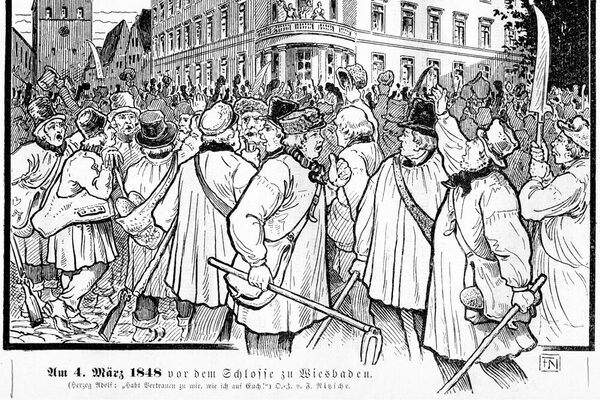Revolution 1848/49
The events of the February Revolution in Paris on February 24, 1848, the initial spark for a series of European revolutions, also fell on fertile ground in Wiesbaden. The reasons for the uprising, especially among the rural population, were primarily of an economic nature. The past failed harvests with subsequent price increases, especially for potatoes, and the first side effects of the beginning industrialization in the Rhine-Main region caused a structural change in working conditions and the emergence of a social protest movement. However, the liberal spokesmen did not want a revolution, but rather the implementation of reforms on a legal basis, an attitude that was also supported by large sections of the Wiesbaden population.
On March 2 and 4, 1848, unprecedented mass rallies took place on Wiesbaden's Schlossplatz, where up to 30,000 people, mainly from the surrounding rural communities, gathered in Wiesbaden. They demanded the immediate implementation of the nine "demands of the Nassauers": the establishment of a citizens' militia, unconditional freedom of the press, the immediate convening of a German parliament, the swearing in of the military to the constitution, freedom of association, publicity in jury trials, the conversion of domains into state property, reform of the electoral law and the widest possible freedom of religion.
Of these, only freedom of the press and the establishment of a militia were initially granted. A 16-member "security committee" subsequently took over de facto government power. However, the people insisted that all demands be granted in full. Due to the absence of the Duke, the situation became increasingly threatening. The crowd made initial attempts to storm the arsenal and theater. A larger group moved resolutely towards the city palace. Isolated demands for the establishment of a provisional government and a republic arose, but did not find a majority in Wiesbaden. An escalation was only prevented by the decisive action of the vigilantes. It is characteristic of the situation in Wiesbaden that it was the bourgeoisie, led by the republican Georg Böhning, who took over the defense of the monarchy. After his return to the capital, the Duke and his government approved all the demands, whereupon he was acclaimed and celebrated by the population.
As early as April, the liberal Jacob Ludwig Philipp August Franz Hergenhahn was appointed Minister of State. In May, a newly elected Nassau state parliament was constituted. The elections and the accompanying media coverage led to a short-term politicization of large sections of the population, which was reflected above all in the brief flourishing of a distinctive newspaper landscape, the many political associations founded, such as the "Republican Society" or the Workers' Association, as well as the numerous petitions submitted to the Frankfurt National Assembly. However, no lasting stabilization of the political situation was achieved, which was mainly due to the deteriorating economic situation, which particularly affected the farmers in the surrounding villages.
As a result, tumultuous scenes broke out in July 1848 when numerous Wiesbaden residents, led by Friedrich Graefe, Oswald Dietz and Georg Böhning, attempted to free imprisoned artillery soldiers. In the end, the city was occupied by federal troops, the citizens' militia was initially disarmed and later comprehensively reorganized. With the failure of the Reich constitution campaign and the associated strengthening of reaction, the old order was largely restored.
Literature
Eiler, Klaus: Opposition and revolution in the Duchy of Nassau. In: Schmidt-von Rhein, Nassauische Residenzstadt [pp. 63-78].
Müller-Schellenberg, Guntram (editor): Revolution in Wiesbaden, eyewitness reports from March 4, 1848, Taunusstein 2008.
